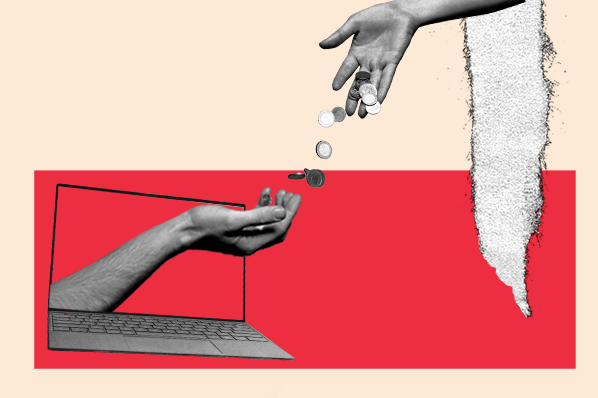Customer Service Buzzwords
- Case Escalation
- Customer-Centric
- Active Listening
- Multi-Channel Customer Service
- Artificial Intelligence (AI)
- Quality Control
- Customer Lifecycle
- Live Chat
- Chatbot
- Case Queue
- Proactive Customer Service
- Social Listening
- Case Quota
- Gamify or Gamification
- WAD (Working As Designed
1. Case Escalation
A case escalation occurs when a frontline service rep either can't solve a problem on their own or if a customer asks to speak to a manager. In this situation, the rep will hand the case off to a colleague or to someone of higher authority who can assist the customer.
When to Use It:
You should only describe a service case as an escalation when speaking to your support colleagues. Telling the customer that, "you're going to escalate their case," tells them that they either have a serious problem or that the rep thinks they're getting agitated or frustrated. For a smoother customer experience, it's better to treat escalations like routine transfers, so the customer doesn't feel like their problems are escalating as well.
Alternatives: Case Transfer, Case Reassignment
2. Customer-Centric
Being customer-centric means that your business puts customer's needs before its own convenience. Rather than cutting corners to save an extra buck, customer-centric companies go the extra mile and do everything they can to delight their customer base.
When to Use It:
Almost every business claims to be customer-centric. So, be mindful that when you proudly use this term to describe your business, your support team needs to actually back up the hype. If you've truly built a business that prioritizes customers, then you should have no problem meeting the high expectations that this buzzword creates.
Alternatives: Customer-Driven, Customer-First, Customer-Focused
3. Active Listening
Active listening means that when a person is talking, you're making a clear effort to show that you're listening. This means being conscious of both your body language and your vocabulary when you're responding to the customer. The more that you can prove that you understand their problem, the more likely they are to trust your advice.
When to Use It:
Customer service managers should use this term when they're teaching or training employees. While you wouldn't want to tell a customer that you're actively listening to them, management should be instructing reps to practice this technique to provide better support.
Alternatives: Two-Way Communication, Conscious Listening
4. Multi-Channel Customer Service
Multi-channel customer service is exactly what it sounds like. When you offer support across two or more communication channels (phone, email, live chat, etc.), you have a multi-channel customer service system.
When to Use It:
Multi-channel customer service is often confused with omnichannel customer service. The difference between the two is that multi-channel customer service simply means that you offer support across two or more channels. With omnichannel customer service, you not only offer support across multiple platforms, but these channels are integrated so customers can transition between them seamlessly.
Alternatives: Multi-Channel Support, Cross-Channel Customer Service
5. Artificial Intelligence (AI)
According to Oxford Languages, AI can be defined as any "computer systems able to perform tasks that normally require human intelligence." While some of us may have an image of humanoid droids in our minds, the reality is that AI describes a wide range of technology. Some are simple workflows that save employees extra time, others are complex algorithms that power core products and services.
When to Use It:
When talking about AI, it's easy to fall into the trap of labeling all new technology as artificial intelligence. We need to be careful, though, because in customer service not everyone is as excited about new technology as your support team is. Some customers are more dubious and will put up a "red flag" as soon as they hear the words "artificial intelligence." For these people, it's better to be more specific about the technology you're using and call the tool by its proper name, if possible.
Alternatives: *Name of Product/Technology*, Smart Technology, Automation
6. Quality Control
Quality control is the section of your business that's responsible for delivering products that meet your customers' expectations. This department makes sure there aren't any flaws in product development and that feedback is gathered shortly after a product is released or when a new order is shipped. If there are any issues, quality control reports back to product development so changes can be made immediately.
When to Use It:
Quality assurance is a better term to use than quality control because assurance shows the customer that you're confident in your ability to meet their expectations. Quality control sounds reactive — like you're trying to control a part of your business that can sometimes go awry. But, quality assurance tells the customer that while problems may pop up, you're going to deliver a high-quality product regardless.
Alternatives: Quality Assurance
7. Customer Lifecycle
The customer lifecycle describes every interaction a person has with your business from start to finish. This includes the moment where they discover your brand and extends beyond their point of purchase. Mapping this journey out gives businesses an idea of what customers go through when they buy something from that company.
When to Use It:
Since customer interactions are rarely cyclical, "customer journey" is becoming a better term to describe a brand's long-term relationship with a customer. While some people may buy from your brand again, their experience with your business is going to be different the second, third, and fourth time they shop with you. Referring to their combined experiences as a journey highlights how these relationships change over time and how the buying process can become smoother for customers as they continue to buy from your business.
Alternatives: Customer Journey, Customer Lifetime
8. Live Chat
Live chat is a text-based communication medium similar to instant messaging. Customers type out their questions, as they would for email support, but unlike email, they're answered within minutes or seconds. The image below shows what this might look like.
%20Them.png)
When to Use It:
While most of us are familiar with this tool, many get confused when the term "live chat" is used. That's because live chat is a fairly technical term, so if you don't work in sales or customer service, you might not have heard someone use its proper name before. For most, we'll just call live chat, "chat," or "messaging" to describe this communication channel.
Alternatives: Chat, Messenger, Customer-Initiated Conversations
9. Chatbot
Chatbots are forms of artificial intelligence that can respond to customer inquiries via live chat. When a customer submits a question, the chatbot identifies the correct pre-written response and automatically forwards it to the customer. This helps customers get a speedy solution to their problems without the need of a human support agent.
When to Use It:
Before using the term, "chatbot," it's important to know the difference between chatbots and other forms of virtual assistants. For example, while chatbots are limited to strictly live chat, interactive virtual assistants (IVAs) can overlay augmented reality elements to further support customers. If you have this type of advanced software, you're selling it short if you're telling customers that it's just a simple chatbot.
Alternatives: Bots, Automated Assistant, *Personalized Name (ex. HubBot)*
10. Case Queue
A case queue can either refer to the number of cases that an individual rep is managing, or it can refer to the total number of support cases that a service team is working on.
When to Use It:
Most customers won't understand what you're talking about if you bring up your case queue. That's because most people don't see how your business operates internally and what goes into running your customer service team. They may just think calls are taken one by one until a solution is provided, then reps go back to sitting by the phone waiting diligently for it to ring.
Alternatives: Caseload, Workload, The/My Queue
11. Proactive Customer Service
Proactive customer service is anything you do to support customers before they bring a problem or question to your team. This can be as simple as sending an email alerting them to a product update or calling to check in if you notice they haven't engaged with your brand for a while. The idea behind this approach is to remove roadblocks for customers before they even know they're there.
When to Use It:
Proactive customer service is a buzzword that you should be using quite frequently. It helps you prioritize customer success and keeps your team constantly looking for opportunities to add more value to the customer experience.
Alternatives: Customer Success, Proactive Support
12. Social Listening
Social listening is a trendy buzzword that describes social media customer service. More specifically, it refers to what your brand does to monitor social media mentions and follower engagement across different accounts and platforms. The faster and more reliable your responses are, the more you can leverage social media as a powerful support channel.
When to Use It:
Since social listening is a relatively new term, the average person likely won't know what you're talking about if you use it in conversation. Unless you're speaking with someone with a marketing or customer service background, then they may have an idea of what social listening is and how brands use it to support customers. However, if you don't interact with someone with this level of expertise, then you might want to use a more direct phrase, like one of the alternatives below.
Alternatives: Social Monitoring, Social Media Customer Management
13. Case Quota
Your case quota is the number of support tickets that you're expected to field or solve within a given day. While this is typically one of many metrics that customer service personnel are measured by, it's usually one of the most important ones that represent a rep's performance.
When to Use It:
This is a phrase that you really don't want to use with customers or with other employees. You shouldn't use it with customers because it can make them feel like a means to an end. They might think that you're trying to resolve their case as fast as you can, so you'll complete your workload with extra time to spare.
You also don't want to use this phrase with your coworkers because it creates a culture that revolves around number-based goals instead of customer success. When everyone is focused on the quantitative side of work, it's easy to overlook the importance of high-quality customer service.
Alternatives: Goal, Benchmark
14. Gamified or Gamification
Gamification takes a menial or dull task and adds gaming elements to it to make it more exciting. An excellent example of this is the game, Jeopardy, which takes simple question-and-answer trivia and turns it into a competitive game show where contestants are rewarded for their intelligence. Without the points, final scores, and "Daily Doubles," Jeopardy would be nothing more than a very dedicated study group.
When to Use It:
Since gamification has proved to be effective, it's becoming a very popular trend in many different industries. With that in mind, you'll want to make sure that you don't overuse the term and risk tiring customers out to it.
Alternatives: Updated, Revolutionized, Redesigned
15. Working As Designed (WAD)
WAD is an acronym that stands for "working as designed." This is a phrase that support reps use when talking about a product that isn't broken. It may mean that the customer mistook a new feature for a glitch, or that the issue that was reported is no longer present. Whatever it was, the product is now functioning normally and is working as designed.
When to Use It:
This is a phrase that should only be used internally by your customer service team. If you say this to customers, they may think you're pushing back against their input or that you don't believe there was a problem in the first place. It's important to always empathize with the customer's position, even if they're convinced a working product isn't behaving normally.
Alternatives: Working as Expected, Working as Intended, Behaving as Expected
For more trendy buzzwords, check out these customer service phrases.
.png?width=112&height=112&name=Image%20Hackathon%20%E2%80%93%20Vertical%20(5).png)



![24 best contact us pages you'll want to copy [+ templates]](https://53.fs1.hubspotusercontent-na1.net/hubfs/53/contact-us-page-1-20251028-243229.webp)

![How to Respond to Customer Complaints [+Complaint Response Examples]](https://53.fs1.hubspotusercontent-na1.net/hubfs/53/Copy%20of%20Featured%20Image%20Template%20Backgrounds%20(8)-1.png)


![How to Write an Apology Letter to Customers [12 Templates & Examples]](https://53.fs1.hubspotusercontent-na1.net/hubfs/53/ai%20customer%20service%20predictions%20(6).png)


